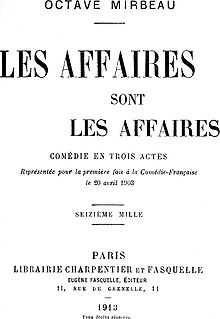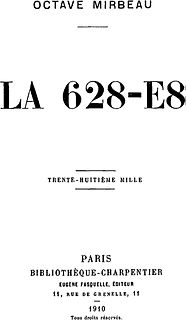 | |
| Author | Octave Mirbeau |
|---|---|
| Original title | 'Dingo' |
| Country | France |
| Language | French |
| Genre | Novel |
| Publisher | Fasquelle |
Publication date | 1913 |
Dingo is a novel by the French novelist and playwright Octave Mirbeau (1913).
 | |
| Author | Octave Mirbeau |
|---|---|
| Original title | 'Dingo' |
| Country | France |
| Language | French |
| Genre | Novel |
| Publisher | Fasquelle |
Publication date | 1913 |
Dingo is a novel by the French novelist and playwright Octave Mirbeau (1913).
Completed by Mirbeau's long-time friend Léon Werth, when the author's ill health prevented him from writing the concluding chapters, Dingo, Mirbeau's final novel, appeared in completed form with Fasquelle in 1913. An autobiographical fiction, Mirbeau's tale chronicles the author's adventures with his pet dog Dingo while simultaneously offering a jaundiced view of country life, in Ponteilles-en-Barcis, a squalid town modeled on the village of Cormeilles-en-Vexin, where Mirbeau had the misfortune to reside.
Carrying on in the same vein as La 628-E8 , in which the hero of the novel had been Mirbeau's automobile, Dingo again takes a non-human as its central character, the marauding, untamed creature that assumes mythical proportions in Mirbeau's book. Uncorrupted by social institutions, endowed with animal good sense, Dingo exposes the vices, duplicity, and venality of the local autochthons while also instructing his "master" in the virtue of living in harmony with the instincts.
Despite praising his dog, Mirbeau offers an unromanticized image of the predatory beast, whose displays of goodness and affection are offset by murderous rampages, his wholesale slaughter of sheep and chickens. Herein Mirbeau shows that man and animal alike obey the "law of murder", whose operation Mirbeau had described in Le Jardin des supplices ( Torture Garden ).

Decentering the masterful human subject who acts as a confident narrator, Mirbeau's novel shows how completely he had broken with the conventions of realist fiction.

Octave Mirbeau was a French novelist, art critic, travel writer, pamphleteer, journalist and playwright, who achieved celebrity in Europe and great success among the public, whilst still appealing to the literary and artistic avant-garde with highly transgressive novels that explored violence, abuse and psychological detachment. His work has been translated into 30 languages.
Dingo refers to the Australian dingo

The Diary of a Chambermaid is a 1900 decadent novel by Octave Mirbeau, published during the Dreyfus Affair. First published in serialized form in L’Écho de Paris from 1891 to 1892, Mirbeau’s novel was reworked and polished before appearing in the Dreyfusard journal La Revue Blanche in 1900.

The Torture Garden is a novel written by the French journalist, novelist and playwright Octave Mirbeau, and was first published in 1899 during the Dreyfus affair. The novel is dedicated: "To the priests, the soldiers, the judges, to those people who educate, instruct and govern men, I dedicate these pages of Murder and Blood."

Business is business is a French comedy in three acts, by the novelist and playwright Octave Mirbeau, performed in April 1903 on the stage of Comédie-Française, in Paris, and worldwide acclaimed, especially in Russia, Germany and United States.

La 628-E8 is a novel by the French novelist and playwright Octave Mirbeau, published by Fasquelle in 1907. Part travelogue, part fantasy, part cultural commentary and critique, Mirbeau's book highlights its own unclassifiability: "Is it a diary?”, the narrator wonders. "Is it even the account of a trip?”
Dans le ciel is a novel written by the French journalist, novelist and playwright Octave Mirbeau. First published in serialized installments in L'Écho de Paris between September 1892 and May 1893, Dans le ciel, assembled and edited by Pierre Michel and Jean-François Nivet, first appeared its present form in 1989.

Là-Bas, translated as Down There or The Damned, is a novel by the French writer Joris-Karl Huysmans, first published in 1891. It is Huysmans's most famous work after À rebours. Là-Bas deals with the subject of Satanism in contemporary France, and the novel stirred a certain amount of controversy on its first appearance. It is the first of Huysmans's books to feature the character Durtal, a thinly disguised portrait of the author himself, who would go on to be the protagonist of all of Huysmans's subsequent novels: En route, La cathédrale and L'oblat.

Le Calvaire (Calvary) is a novel written by the French journalist, novelist and playwright Octave Mirbeau, and published by Ollendorff in 1886.

L'Abbé Jules is a novel written by the French journalist, novelist and playwright Octave Mirbeau, and published by Ollendorff in 1888.

Les Vingt et un Jours d'un neurasthénique is an expressionist novel by the French writer Octave Mirbeau, published by Charpentier-Fasquelle in August 1901.

Pierre Michel, is a professor of literature and a scholar specializing in the French writer Octave Mirbeau.

Cahiers Octave Mirbeau is a French literary journal founded in 1994 by French scholar and Octave Mirbeau specialist Pierre Michel.
Père Pamphile is a fictional character in the novel Abbé Jules, by the French writer Octave Mirbeau (1888). While he is only a marginal figure in Mirbeau's tale, Père Pamphile is nonetheless am extraordinary and striking character, whose history Mirbeau retraces in the course of a long flashback.

Lucien is one of the central fictional characters in the novel Dans le ciel, by French writer Octave Mirbeau.

Célestine is the main character and the narrator of the French novel by Octave Mirbeau, The Diary of a Chambermaid, 1900.
Clara is the main character in the French novel The Torture Garden, by Octave Mirbeau.
La Mort de Balzac by Octave Mirbeau is a collection of three sub-chapters that were initially intended to appear in Mirbeau's La 628-E8, in November 1907, but were then withdrawn at the last moment at the request of the 80-year daughter of Madame Hanska, the Countess of Mniszech. La Mort de Balzac was published by Pierre Michel and Jean-François Nivet in 1989, in the Editions du Lerot, and then in 1999, in the Editions du Félin. Published at « the expenses of an admirer », in earlier edition, limited to 250 copies, the three sub-chapters had appeared in 1918 under the title Balzac.
Contes cruels is a two-volume set of about 150 tales and short stories by the 19th-century French writer Octave Mirbeau, collected and edited by Pierre Michel and Jean-François Nivet and published in two volumes in 1990 by Librairie Séguier. The title was taken from Auguste Villiers de l'Isle-Adam, of whom Mirbeau was a friend and admirer.
Combats littéraires is the title of a 2006 collection of 187 articles and prefaces written by the French writer Octave Mirbeau, between 1876 and 1916, on literature, journalism, and publishing over the course of his long career as an influential journalist. Although Mirbeau collaborated with numerous daily newspapers, he was never officially assigned the work of literary reviewer. Of these articles, some 60 were published between 1925 and 1926 under the title Les Écrivains, and these are available on Wikisource.